Peperomias, or radiator plants, are great beginner plants. And because peperomia foliage comes in a wide variety of shapes, sizes, colors, and textures—with over 1,000 species of peperomia, you’re sure to find one to fall in love with! Native to the tropical areas of Central America and South America, these succulent-like plants thrive on relatively high humidity, low to medium amounts of water, and medium to bright indirect light. Let’s talk about peperomia care.

Table of Contents
How big do peperomia plants get?
With a few exceptions, most species of peperomia stay fairly small. This makes them an excellent choice for small spaces where you just need to add a bit of life. Various peperomias can trail, mound, stay compact, or grow upright, so there is sure to be one that fits the space you are looking to fill!
How do you take care of a peperomia plant?
Peperomia care: light requirements
Peperomia plants will do best in medium to bright indirect light, and thrive in east- or west-facing windows. However, many can handle low light or even fluorescent light. Be aware that growth will be much slower under a lower light situation, and the plant will need less water, so be sure not to overwater if that is the case!
If you take your plants outside in the summer, avoid direct sunlight for your peperomia.
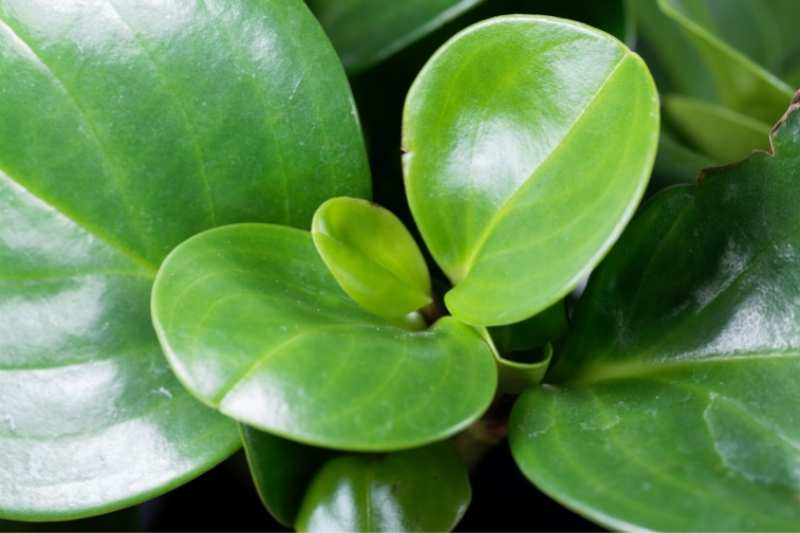
Peperomia care: water needs
With peperomias, it is better to err on the side of underwatering than overwatering. These plants are especially susceptible to root rot, and that is hard to come back from—so no excessive watering!
Peperomias are succulent-like plants, and their thick leaves allow them to retain water and go a bit longer between waterings. So if you are occasionally a forgetful plant parent, peperomia may be the plant for you—they can forgive a missed watering session here and there (zz plants are another good option if this is you!)
Let the soil dry out between watering—if the leaves and stems still feel firm and the potting soil still feels moist, you can wait a bit to water. Peperomia varieties with thicker, waxier leaves are more succulent like and can go longer between watering sessions.
When it is time to water your peperomia, use a chopstick to gently poke holes into the soil, being careful not to stab the roots. This will aerate the soil and allow the water to reach all parts of the roots. Then water slowly and thoroughly, until you see water streaming out of the drainage holes. Allow the water to drain thoroughly and not sit in the saucer for too long.

Peperomia care: everything else
Potting Mix: Because peperomia are prone to root rot, you’ll want to use a light, well-draining potting mix and a pot with drainage holes. Try an orchid bark mix, or amend your regular potting mix with one of these blends.
Fertilizer: In the summer, feed your peperomia every few weeks, though you can drop this down to about once a month or a little less in the winter. A balanced houseplant fertilizer will do the trick, but if you can get your hands on one that is a little richer in nitrogen, that’s even better.
Humidity: In their native tropical environment, peperomia get plenty of humidity, so for the healthiest plant, you’ll want to replicate that at home. If you live in an arid climate, you can use a humidifier or pebble tray to boost the humidity level. However, peperomia are fairly forgiving plants, and yours may do just fine in drier air.

Can peperomia live outside?
They can! Peperomias will do best in shade to dappled sun outdoors in the warmer months—avoid direct sunlight. Just be sure to bring them back inside before the overnight temperatures hit the 50s.
How do you know if peperomia needs water?
Rather than relying on a set schedule for watering your peperomia, your best bet is to watch your plant for visual cues that it is ready for another drink:
- Feel the leaves. Your peperomia’s leaves should feel firm. If they are feeling floppy or soft, your plant needs more moisture.
- Check the soil. Stick your finger in the soil—the top two inches should be dry before you give your plant more water.
In general, your watering frequency will be higher if your peperomia is in brighter light or has thinner leaves.
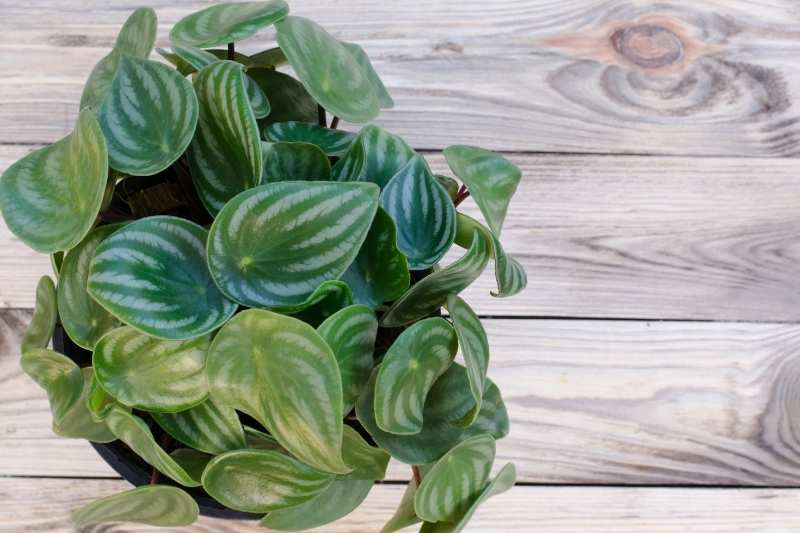
Peperomia varieties
There are over a thousand peperomia species, and we couldn’t possibly cover them all here! But here are some of the classics and some of our favorites, which should give you an idea of the wide world of peperomias!
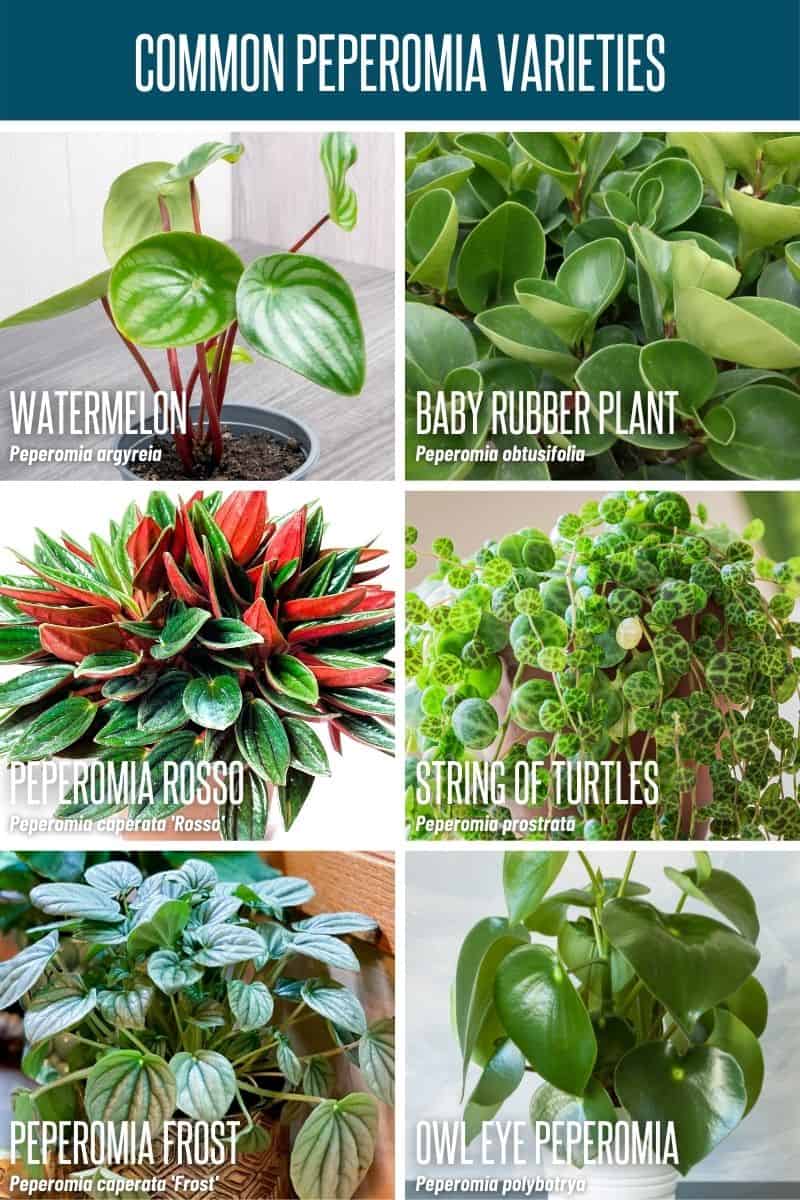
- Watermelon peperomia (Peperomia argyreia) is known for its dark green leaves with lighter parallel stripes and red stems.
- Baby rubber plant (Peperomia obtusifolia) is another upright peperomia, with oval leaves that may be green or variegated.
- Peperomia Rosso (Peperomia caperata ‘Rosso’) has lance-shaped green leaves with deep ridges and bright red undersides.
- String of Turtles (Peperomia prostrata) is a trailing peperomia with small round leaves that are patterned like turtle shells.
- Peperomia Frost (Peperomia caperata ‘Frost’) is a mounding peperomia with deeply ridged or rippled silvery leaves.
- Owl Eye Peperomia (Peperomia polybotrya) is one of the larger peperomia, with large, tear drop-shaped leaves that grow on upright stems.
Plant problems
Pests. Peperomias are fairly pest resistant, but they can be susceptible to mealybugs. To protect your plant from mealybugs and other pests, you can use a preventative spray like horticultural oil or something like this Leaf Wellness Spray (my personal favorite).
Root Rot. Peperomias are particularly prone to root rot, and the best (and sometimes, only) treatment for root rot is to prevent it in the first place. To avoid root rot, make sure you are choosing the right size pot for your peperomia—a too big pot will hold excess moisture near the roots for too long. Also, be sure to allow the soil to dry out between waterings.
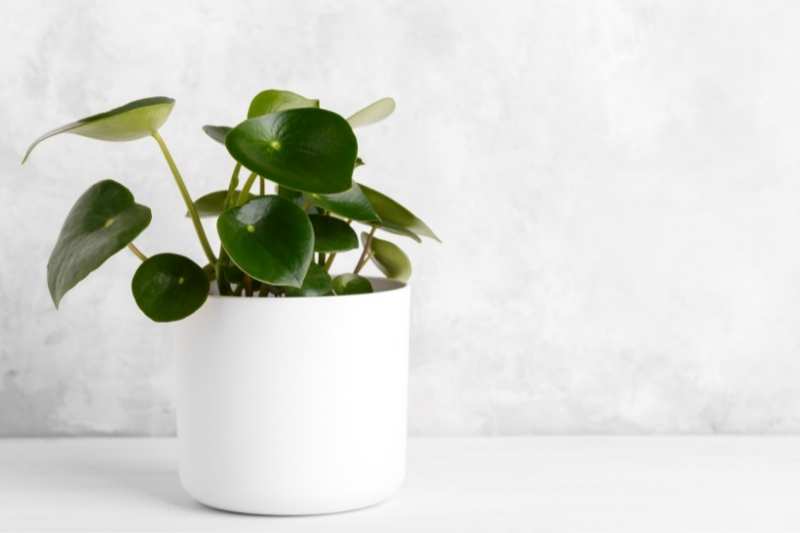
Edema. Swollen spots on the leaves of your peperomia, or brown, cork-like bumps that cannot be rubbed off, are a sign of edema. Edema is a sign of overwatering or uneven watering, and while it won’t necessarily harm your plant, it also won’t disappear from already-affected leaves. Moving forward, be sure to only water your peperomia when the top two inches of soil are dry and the leaves are feeling a bit floppy, and to aerate the soil before watering.
Leaf Drop. A peperomia that is losing leaves is unhappy with its watering situation. More often than not, it is a sign of overwatering. Signs of overwatering to check for: the leaves feel plump and firm, the petioles feels squishy or look dark, or the potting soil is constantly moist. If it doesn’t appear to be an issue of overwatering, make sure that your peperomia isn’t near a cold draft, underwatered, or in direct sunlight.
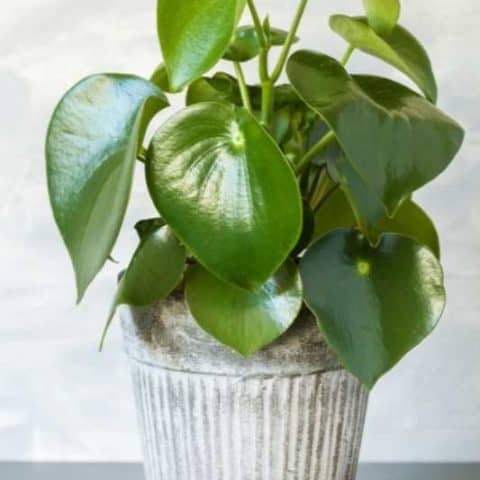
Peperomia Care Guide
The only thing you need to know in order to take care of this adorable little plant is how much to water it. Everything else is easy peasy!
Materials
- Peperomia Plant
Tools
- Container with a Drainage Hole
Instructions

- Err on the side of underwatering. Peperomia are particularly prone to root rot. Be sure to allow the top two inches of soil to dry out between watering sessions.
- Plants with thinner leaves will need water more often. Thicker, waxier leaves can hold more water, so peperomia with these thicker leaves will need less frequent waterings than their thinner-leaved counterparts.
- Aerate the soil. When it is time to water, gently poke the soil with a wooden chopstick, being careful not to stab the roots. Pour the water slowly over the entire surface of the soil until you see water draining out of the drainage holes at the bottom of the container. This way, water and air will reach all the parts of the roots.
- Avoid direct light. Keep your peperomia out of direct sunlight. Peperomias can handle a wide range of light environments, just remember that they will use up their water more quickly in brighter light. You will need to water less frequently if your peperomia lives in a lower light environment.

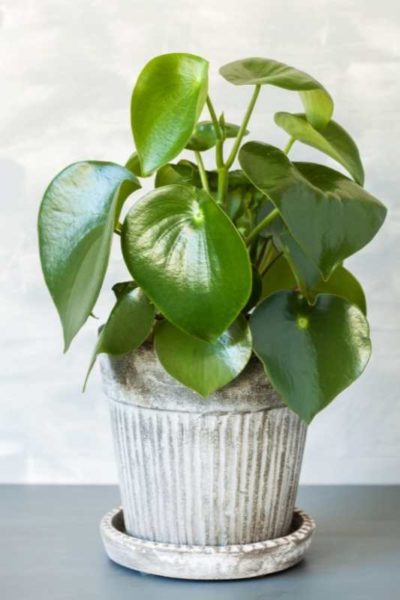






How do you know when a peperomia needs transplanting?
If you see the roots poking out of the bottom, or the plant needs to be watered more often, it may be time to repot. You can see more repotting signs here: https://growfully.com/how-to-repot-a-plant/
My peperomia has yellow, firm leaves among the green. Is that bad?
That could be a sign of overwatering. Try waiting to water again until the pot feels light and the leaves feel limp—the leaves that are already yellow won’t turn green again, but it might help prevent more from yellowing. I would also give the plant a good inspection for any pests, which can also cause yellowing leaves.
I have brown flat spots on my peromia plant and do not know how to treat it. The plant’s leaves are green with yellow on the edges.
Asking for advise and thank you.
It sounds like your peperomia is overwatered—make sure you are watering the soil and not the leaves, and letting the soil dry out between waterings. If the brown spots feel/look a little like cork, it is probably the watering issue. Those spots won’t go away, but more even and spaced out watering should help prevent more from developing. If the brown spots are mushy, it may have a fungal disease, and you’ll want to remove the infected leaves (make sure to sterilize your scissors/pruners after!) and let the plant dry out a bit before you water again.